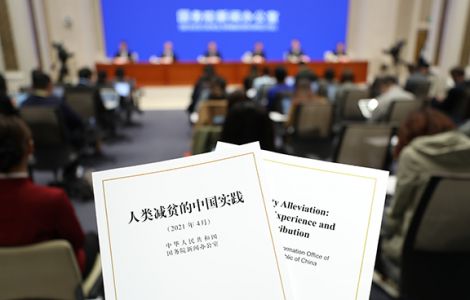中英对照:《人类减贫的中国实践》白皮书 [11]
Poverty Alleviation: China's Experience and Contribution [11]
再到中共十八大以来实行农村承包地所有权、承包权、经营权“三权分置”和推进农村集体产权制度改革,
• By separating the ownership rights, contracting rights, and management rights for contracted rural land and further reforming the rural collective property rights system since the 18th CPC National Congress in 2012.
不断消除导致贫困的制度性、结构性因素,不断促进农村发展、农民增收。积极顺应全球化潮流,坚定不移扩大对外开放,对外贸易持续快速增长,为广大农村劳动力创造了大量就业岗位、拓宽了增收渠道。
These measures have contributed to rural development and increased farmers' incomes. In addition, China has opened wider to the world amidst economic globalization and seen sustained and rapid growth in its foreign trade, creating many employment opportunities and more sources of higher incomes for rural labor.
新中国成立以来特别是改革开放以来,中国经济社会快速发展,经济总量不断跃升,综合实力显著提升,既对减贫形成了强大的带动效应,也为大规模扶贫开发奠定了坚实基础、提供了有力保障。
Since the founding of the PRC in 1949, and especially since the launch of reform and opening up in 1978, the country has witnessed rapid economic and social development, with the economy and national strength growing steadily. This has provided solid support for large-scale development-driven poverty alleviation effort.
中国减贫实践表明,发展是消除贫困最有效的办法、创造幸福生活最稳定的途径。唯有发展,才能为经济社会发展和民生改善提供科学路径和持久动力;唯有发展,才能更好保障人民的基本权利;唯有发展,才能不断满足人民对美好生活的热切向往。
China's experience with poverty alleviation has proven that development is the most effective way to eradicate poverty and the most reliable path towards a more prosperous life. Only development can lead to economic growth, social progress and higher living standards. Only development can better guarantee people's basic rights and meet their desire for a better life.
(四)立足实际推进减贫进程
4. Pressing Ahead with Poverty Alleviation Based on Reality
贫困问题具有多样性和复杂性,致贫原因也呈现差异性和多元性。中国立足本国国情,根据不同发展阶段和经济社会发展水平,根据贫困人口规模、分布、结构等的变化,科学制定减贫标准、目标、方略,不断创新减贫理念、方法、手段,循序渐进、持续用力、滴水穿石。新中国成立后,主要是通过社会制度变革和大规模社会主义建设减缓贫困。改革开放以来,主要是通过农村经济体制改革和经济增长带动减贫,重点采取开发式扶贫方针,引导贫困地区和贫困群众以市场为导向,调整经济结构,开发当地资源,发展商品生产,提高自我积累、自我发展能力。进入新时代,在继续坚持开发式扶贫的同时,实施精准扶贫方略,扶贫路径由“大水漫灌”转为“精准滴灌”,资源使用方式由多头分散转为统筹集中,扶贫模式由偏重“输血”转为注重“造血”,考评体系由侧重考核地区生产总值转为主要考核脱贫成效。中国根据经济社会发展和减贫事业推进的实际,逐步调整提高扶贫标准,让发展成果更多更好惠及人民群众。
Poverty problems, as well as their causes, are diverse and complex. China's poverty alleviation efforts are based on a realistic appraisal of the situation. China has set its poverty line and its poverty alleviation goals and strategies, and worked to create better ideas and methods based on its national conditions and stage of development, and on the changes in the demographics, distribution, and structure of the poor population. It has advanced this undertaking step by step and with a steady effort. Immediately after its founding in 1949, the PRC addressed the problem of poverty mainly through reform of the social system and large-scale economic development. After the launch of reform and opening up in 1978, China drove poverty alleviation mainly through rural economic reform and economic growth. It adopted development-oriented measures, guiding people in impoverished areas to increase their capacity for accumulation of wealth and endogenous development by adjusting the local economic structure, tapping into local resources, and developing production in response to market demand. In the new era, China has continued previous measures, and at the same time carried out a strategy of targeted poverty alleviation. The approach has changed from generalized broad-brush policies to targeted measures based on specific conditions. Before, resources for poverty alleviation came from multiple sources and were used by scattering them among the impoverished areas; now they are concentrated and better coordinated. The model of poverty alleviation has changed from mainly relying on external support like a blood transfusion to a more sustained effort from self-motivation. The assessment system has shifted focus from regional GDP as the main indicator to the genuine result of poverty alleviation. China has gradually lifted its poverty line based on its economic and social advances and progress in the cause of poverty alleviation to share the fruits of development with more people.
中国减贫实践表明,贫困的发生演变有其自身特点和规律,贫困治理必须从实际出发,科学研判制约减贫和发展的瓶颈因素,找准释放减贫动力的突破口,因时因势因地制宜,不断调整创新减贫的策略方略和政策工具,提高贫困治理效能。
The occurrence and evolution of poverty has its own features and trends. To achieve success in reducing poverty, a country must follow a path in line with its national conditions, identify and remove obstacles to poverty alleviation, find driving forces for this cause, and constantly adjust and reform its strategies and policies as circumstances and local conditions change.
(五)发挥贫困群众主体作用
5. Letting the Poor Play the Principal Role
贫困群众是脱贫致富的主体。扶贫减贫既要借助外力,更要激发内力,才能形成合力。中国充分尊重、积极发挥贫困群众主体作用,激发培育贫困群众内生动力,增强参与发展、共享发展、自主发展的能力,使贫困群众不仅成为减贫的受益者,也成为发展的贡献者。坚持扶贫与扶志扶智相结合,既富口袋,更富脑袋,让贫困群众既有脱贫致富的想法,又有脱贫致富的办法。依托农民夜校、新时代讲习所等,加强教育培训,提升贫困群众发展生产和务工经商的基本技能。改进扶贫方式,建立正向激励、比学赶超的有效机制,更多采用生产奖补、劳务补助、以工代赈等方式,激励贫困群众依靠劳动创造幸福。大力宣传自强不息、奋斗脱贫的先进典型,广泛开展生动活泼、形式多样的宣传教育,引导贫困群众树立“宁愿苦干、不愿苦熬”的观念,用双手改变贫困落后面貌。
Poor people are the main players in eliminating poverty. Poverty alleviation requires both external and internal forces to form a synergy. China fully respects the principal role of the poor and encourages them to play their part, inspires them with the motivation to fight poverty, and enhances their ability to participate in development, share the fruits of development, and achieve endogenous development. They benefit from success in the undertaking of poverty alleviation and at the same time contribute to development in China. China has inspired its people in poverty to strive for prosperity and provided them necessary education, so that they have the ambition to emerge from poverty and the tools to succeed. People in poverty have had better access to education opportunities, such as farmers' night schools and training workshops, to improve their skills and abilities in work and business. A significant improvement in the battle against poverty is an effective mechanism of positive incentives encouraging the poor to learn from and keep pace with each other. Through this mechanism, productive activities are rewarded and subsidized and jobs instead of grants are provided, to encourage poor people to rely on their own efforts rather than wait for external assistance. China has promoted stories of role models who escaped poverty through their hard work. It has also carried out various activities to establish the idea that "It is better to work hard than to endure poverty." The people in poverty have followed suit and eventually shaken off poverty and backwardness.
中国减贫实践表明,人民是历史的创造者、推动者,是顶天立地的真正英雄。只要坚持为了人民、依靠人民,尊重人民主体地位和首创精神,激励贫困群众自力更生、艰苦奋斗的内生动力,就一定能够战胜贫困。
The fight against poverty shows that the people are the creators and drivers of history, and the true heroes. As long as a country serves the people, relies on them, respects their principal status and pioneering spirit, and motivates the poor to rely on their own hard work, it is sure to defeat poverty.
注:为确保中英对照准确,“热词译”网站可能对中英文重新分段。

